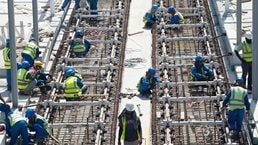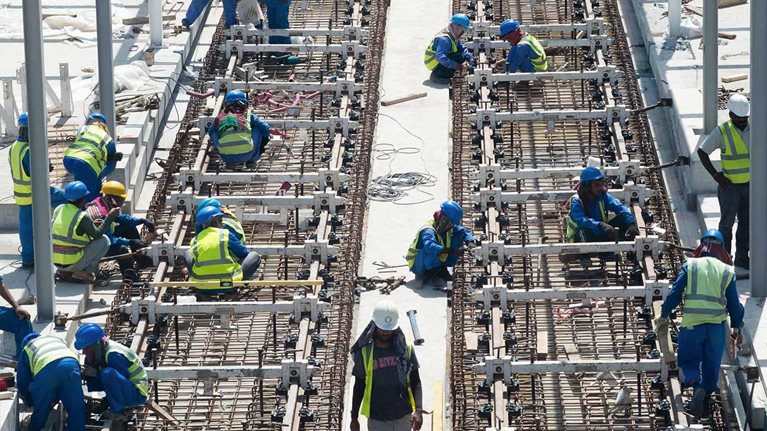The construction industry employs about 7 percent of the world’s working-age population and is one of the world economy’s largest sectors, with $10 trillion spent on construction-related goods and services every year. But the industry has an intractable productivity problem and, according to Reinventing construction: A route to higher productivity, a new McKinsey Global Institute report, an opportunity to boost value added by $1.6 trillion.
Other sectors have transformed themselves and their productivity performance. In retail, the mom-and-pop stores of half a century ago have been replaced by large-scale modern retailers with global supply chains and increasingly digitized distribution systems and customer-intelligence gathering. In manufacturing, lean principles coupled with extensive automation have utterly changed industries.
In comparison, much of construction has evolved at a glacial pace. Take one example: construction is among the least digitized sectors in the world, according to MGI’s digitization index. In the United States, construction comes second to last, and in Europe it is in last position on the index.
Globally, labor-productivity growth in construction has averaged only 1 percent a year over the past two decades, compared with growth of 2.8 percent for the total world economy and 3.6 percent in the case of manufacturing. In a sample of countries analyzed, over the past ten years less than one-quarter of construction firms have matched the productivity growth achieved in the overall economies in which they work. There is a long tail of usually smaller players with very poor productivity, and many construction projects suffer from overruns in cost and time.
If construction-sector productivity were to catch up with that of the total economy—and it can—this would boost the sector’s value added by an estimated $1.6 trillion, adding about 2 percent to the global economy, or the equivalent of meeting about half of the world’s infrastructure need (exhibit). One-third of the opportunity is in the United States.

Would you like to learn more about the McKinsey Global Institute?
Absent change, global needs for infrastructure and housing will be hard to meet. Despite huge potential for additional value added, and despite the fact that the challenges are well known and have been long discussed in the industry, progress has been limited.
The new MGI Construction Productivity Survey confirms many reasons for the persistently poor performance. The industry is extensively regulated and highly dependent on public-sector demand; informality and sometimes corruption distort the market. Construction is highly fragmented: contracts have mismatches in risk allocations and rewards; often, inexperienced owners and buyers find it hard to navigate an opaque marketplace. The result is poor project management and execution, insufficient skills, inadequate design processes, and underinvestment in skills development, R&D, and innovation.
The productivity performance of global construction is not uniform. There are large regional differences, and major variations within the industry. The sector splits broadly in two: large-scale players engaged in heavy construction such as civil and industrial work and large-scale housing, and a large number of firms engaged in fragmented specialized trades such as mechanical, electrical, and plumbing work that act as subcontractors or work on smaller projects like refurbishing single-family housing. The first group tends to have 20 to 40 percent higher productivity than the second.
Examples of innovative firms and regions suggest that acting in seven areas simultaneously could boost productivity by 50 to 60 percent. They are reshaping regulation; rewiring the contractual framework to reshape industry dynamics; rethinking design and engineering processes; improving procurement and supply-chain management; improving onsite execution; infusing digital technology, new materials, and advanced automation; and reskilling the workforce.
Parts of the industry could move toward a manufacturing-inspired mass-production system, in which the bulk of a construction project is built from prefabricated standardized components off-site in a factory. Adoption of this approach has been limited thus far, although it’s increasing. Examples of firms that are moving in this direction suggest that a productivity boost of five to ten times is possible.
Today, the industry is in deadlock—to break it will require movement from all players. Owners should be the main beneficiaries of a move to a more productive model that will eventually reward them with higher schedule reliability and lower costs. But they are generally risk averse and not sufficiently experienced to navigate an opaque market. Only when there is a sufficiently broad range of contractors and production-system-based players that can offer more standardized products at lower price points may they change their procurement practices.

Bridging global infrastructure gaps
For their part, contractors and specialized trades may stand to lose from a move to a more efficient system in which many of them win orders by optimizing up-front pricing and then making up for lost surplus via change orders and claims, or where nonstandard or costly specifications can mean higher revenue rather than lower margins. Currently, many contractors are more focused on maintaining those margins than measuring and improving productivity.
Some governments are now taking an active approach to boosting construction-sector productivity through regulation. The impact of such efforts may be reinforced by a number of forces that are bringing down barriers to change. Demand is rising; the scale of players and projects is increasing, making a more productive new system more viable; and the price of productivity-enhancing technology and digital tools is falling, making them more accessible, while increasing market transparency and disrupting small trades. With labor costs rising, the case for productivity-enhancing technology only becomes more pressing.


